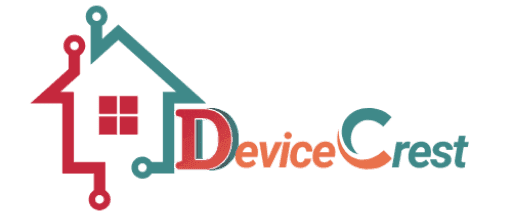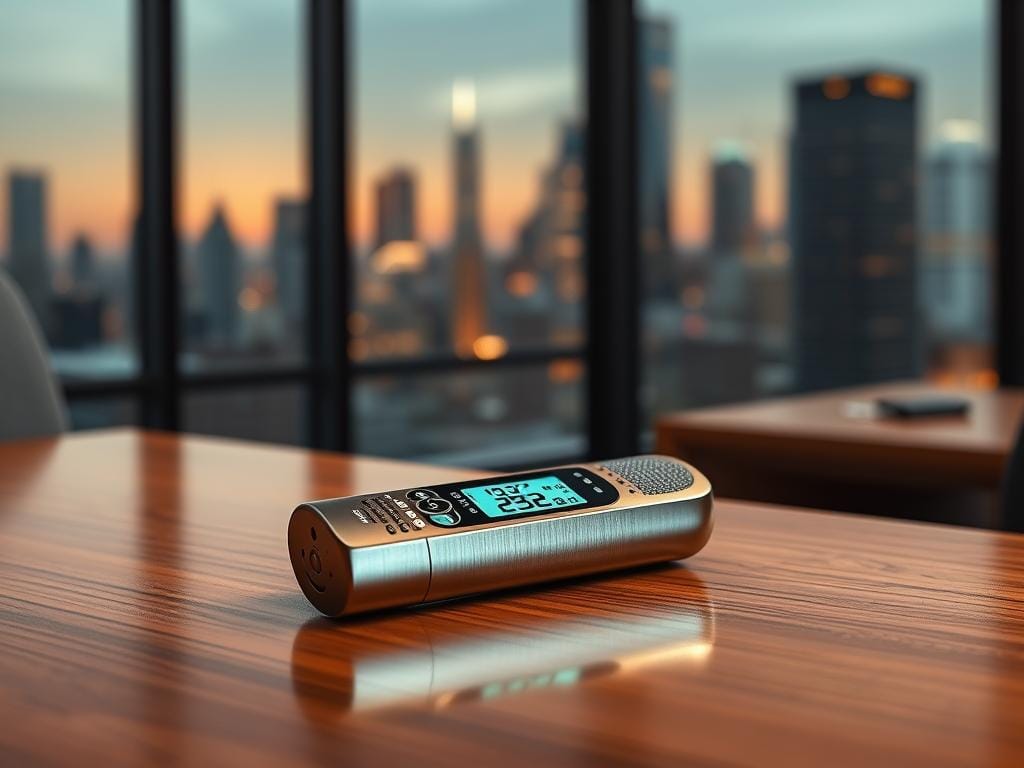Did you know that top digital voice recorders can record audio at 1536Kbps? This quality is as good as studio equipment. These devices have changed how we record and keep important moments.
Digital voice recorders are key for professionals, students, and creatives. They help get clear audio recordings. Whether it’s lectures, interviews, or ideas, the right device makes a big difference.
Today’s digital voice recorders are packed with advanced tech in small sizes. They have features like noise-canceling and lots of storage. These devices are more than just recorders. They’re advanced tools that change how we capture and keep sound.
Key Takeaways
- Digital voice recorders offer professional-grade audio quality
- Advanced noise-canceling technology ensures clear recordings
- Compact devices with extensive storage capabilities
- Multiple recording formats and high-quality sound capture
- User-friendly interfaces make recording simple and intuitive
Understanding Voice Recording Technology
Digital voice recording has changed how we record audio. It’s used in lectures and professional interviews. The journey started with early magnetic recording technologies. These led to today’s digital dictation machines.
The story of recording technology is one of innovation. In 1900, Valdemar Poulsen showed the first magnetic recording. It used steel wire to capture audio. This invention was the start of today’s advanced recorders.
Digital vs Analog Recording Methods
Modern recording tech has big advantages over old methods:
- Higher audio quality and precision
- Easier file management and transfer
- Enhanced noise reduction capabilities
- Compact storage solutions
WAV vs MP3 File Formats
Choosing the right file format is key for quality and storage. Here’s a quick look:
| Format | Audio Quality | File Size | Best Use |
|---|---|---|---|
| WAV | Uncompressed, High | Large | Professional recordings |
| MP3 | Compressed, Good | Small | Everyday recordings |
Sampling Rates and Bit Depth Explained
Sampling rates are important for picking the right recorder. Higher sampling rates capture more audio details. This means clearer recordings for lectures, interviews, and work.
Today’s digital voice recorders have cool features like 32-bit float recording. They offer top-notch audio capture in many settings.
Professional-Grade Digital Voice Recorder Features

Digital voice recorders have become advanced tools for professionals. They help capture high-quality audio. Now, we can document and save important info in many fields thanks to speech-to-text transcription.
Professional-grade recorders come with many advanced features. These are designed to handle tough recording tasks:
- Advanced noise reduction technology
- Hands-free audio recording options
- Multiple microphone configurations
- High-resolution audio capture
What makes professional recorders stand out includes:
| Feature | Professional Specification |
|---|---|
| Audio Quality | 1536Kbps crystal-clear recording |
| Memory Capacity | 144GB (16GB built-in + 128GB expandable) |
| Battery Life | Up to 70 hours continuous recording |
| Security | 6-digit password protection |
Journalists, media workers, and audio engineers use these devices. They help capture detailed sound environments. The speech-to-text transcription feature is a big help, saving a lot of time.
Professional audio recording is not just about capturing sound—it’s about preserving moments with precision and clarity.
Modern digital voice recorders are great for recording interviews, lectures, or music. They offer flexibility with hands-free recording. This meets the needs of many professionals.
Best Voice Recorders for Different Uses

Choosing the right portable voice memo device depends on your needs. Whether you’re a student, journalist, musician, or professional, picking the right tool is key. It helps capture clear audio.
Recorders for Lectures and Meetings
Students and professionals need reliable devices for recording. Here are some top picks:
- Sony ICD-PX470: Great for recording in big lecture halls
- Olympus WS-853: Has adjustable playback for better note-taking
- Zoom H1: Lasts up to 12 hours for non-stop recording
Devices for Music Production
Musicians and audio experts need top-notch recording gear. Look into these options:
- Tascam DR-05: Can expand up to 128GB for long recordings
- Professional devices with multi-track recording
- Supports formats like MP3, WAV, and FLAC
Options for Field Recording
Outdoor lovers and field researchers need tough devices. Look for these features:
- Noise reduction tech
- Rugged design
- Long battery life
- Cloud storage integration
Pro tip: Always check device compatibility with your specific recording requirements before making a purchase.
Audio Quality and Sound Clarity Factors

Getting clear audio is key when picking a dictation device. Digital Signal Processors (DSPs) are vital in making raw sound into perfect recordings. They work hard to improve lecture recording and speech-to-text.
What affects audio quality includes:
- Digital Signal Processing capabilities
- Microphone sensitivity
- Noise reduction technologies
- Audio file formats
Modern DSPs make audio clearer with advanced methods:
- Real-time noise reduction
- Dynamic range compression
- Precise frequency equalization
- Echo and reverb cancellation
When picking a recorder, think about these tips for better audio:
- Choose uncompressed formats like WAV for the best sound
- Go for higher bitrates (256 kbps or above)
- Use devices with advanced noise-canceling chips
- Look at sample rates and bit depth
Top-notch dictation devices use special microphones and smart audio processing. They capture sound with amazing accuracy. Whether for lectures, interviews, or speech-to-text, knowing these audio factors leads to better results.
Storage Options and Battery Life Considerations

Choosing the right digital voice recorder means looking at storage and battery life. It’s important to find devices that record voice notes and memos well without stopping.
Internal and External Storage Solutions
Today’s voice recorders have different storage options. They usually come with:
- 4GB internal memory
- Expandable storage via microSD card
- Maximum external storage up to 64GB
Devices like the Zoom H1 and Tascam DR-05 let you add more storage with microSD cards. This means you can record more voice memos and longer sessions.
Battery Duration and Power Management
Battery life is key for recording without breaks. Important battery features include:
- Up to one week of battery life with 1-2 hours daily use
- Rechargeable lithium-ion batteries
- USB charging capabilities
Pro tip: Choose devices with USB ports for charging and transferring files. This makes it easier for those who love recording voice notes.
File Management Systems
Good file management makes recording better. Top recorders offer:
- MP3 audio recording at 192kbps
- Easy file organization
- Seamless transfer between devices
These devices are small and light. They’re perfect for carrying around and recording important voice notes anywhere.
Top Recording Features and Functions
Modern portable recorders have changed how we take notes and record audio. They now have advanced features that make recording sound easy and smart.
Speech recognition has been a big help for work and school. Now, digital voice recorders can turn spoken words into text. This makes writing down what was said much quicker and more accurate.
- Voice activation technology that starts recording automatically
- Real-time transcription across multiple languages
- Noise reduction for crystal-clear audio capture
- Cloud storage integration for seamless file management
The newest portable recorders have amazing features. Let’s look at some key ones that make top devices stand out:
| Feature | Capabilities |
|---|---|
| Recording Range | 3-meter pickup with dual microphone array |
| Battery Life | 10 hours continuous recording |
| Storage | Supports SDXC cards up to 256GB |
| Connectivity | Bluetooth with 10-meter range |
Professional-grade recorders now offer unprecedented flexibility for users across various domains, from academic research to creative industries.
“Technology is best when it empowers human potential” – Unknown
With features like multi-language translation and cloud syncing, digital voice recorders have become more than just recording tools. They are now smart tools for getting work done.
Digital Voice Recorder Price Comparison
Choosing the right digital voice recorder depends on your budget and needs. We’ll look at different price ranges to find the best transcription tool for clear audio memos.
Budget-Friendly Options
For beginners or those with simple needs, budget-friendly digital voice recorders are great. They cost between $30 and $50. They have the basics for students, researchers, and casual users.
- Compact design
- Basic audio memo functionality
- Simple file management
- Limited storage capacity
Mid-Range Solutions
Mid-range digital voice recorders offer a good mix of price and features. They cost between $50 and $150. These are for professionals who need reliable tools with more features.
| Price Range | Features | Best For |
|---|---|---|
| $50-$100 | Noise reduction, longer battery life | Business professionals |
| $100-$150 | Advanced storage, better audio quality | Journalists, researchers |
Professional Equipment Investment
High-end digital voice recorders are a big investment for serious audio pros. They cost from $200 to $500. These devices offer studio-grade recording quality and lots of features.
- Professional-grade audio capture
- Extensive storage options
- Advanced noise cancellation
- Multiple input/output configurations
When picking a digital voice recorder, think about your needs, budget, and use. This will help you find the best device for top-notch audio memos.
Connectivity and File Transfer Capabilities
Modern digital voice recorders have changed the game with their advanced connectivity. These devices now make it easy to transfer files and work across different platforms.
Key connectivity options for voice recording devices include:
- USB-C port for high-speed file transfers
- Wireless transfer capabilities via Wi-Fi
- Cloud storage integration with Google Drive and Dropbox
- USB audio interface functionality
Recording lectures is now super easy thanks to USB 2.0 High-Speed mass storage class support. You can move audio files between devices easily, supporting formats like WAV and MP3. The USB-C port lets you connect directly to your computer, turning your recorder into a 2-in/2-out audio interface.
These advanced devices also support external Bluetooth microphones. This adds more flexibility to your recording needs. With sampling frequencies of 44.1/48 kHz and 24-bit quantization, you get top-notch audio quality for any recording.
Seamless connectivity means your recordings are always accessible, wherever you are.
Cloud integration makes syncing files across devices automatic. This makes managing your files a breeze for professionals, students, and content creators.
Voice Activation and Noise Reduction Technology
Modern digital voice recorders have changed how we record speech. They use advanced voice activation and noise reduction tech. These smart features make capturing and processing voice notes and memos easier.
AI-powered noise reduction tools have made audio recordings much better. Tools like Krisp and Descript’s Studio Sound use machine learning to clean up audio. They can:
- Eliminate background noises in real-time
- Distinguish between desired sounds and ambient interference
- Automatically enhance recording clarity
Voice activation tech takes recordings further by smartly detecting sound levels. Devices can now start and stop recording automatically based on acoustic triggers. This saves battery and storage during long talks or interviews.
Professional-grade noise cancellation tools like Krisp offer amazing features:
- Remove background voices and echoes
- Provide bot-free recording experiences
- Support mobile and desktop platforms
- Transform noisy environment recordings with a single click
Popular podcasts like Planet Money and Freakonomics Radio use these advanced techs. They show how much of a difference good noise reduction makes in audio quality.
Essential Accessories and Add-ons
Choosing the right digital voice recorder is just the start. The right accessories can make your note-taking and speech recognition better. This makes capturing audio more efficient and professional.
When looking for essential add-ons, consider these key accessories. They can improve your recording workflow:
- External Microphones
- Lavalier mics for clear interview audio
- Shotgun mics for directional sound capture
- USB podcast microphones for enhanced vocal clarity
- Transcription Tools
- Foot pedals for hands-free control
- Noise-canceling headphones
- Transcription software integration
- Protection and Mobility
- Padded protective cases
- Portable tripods
- Wrist straps for secure handling
We’ve put together a detailed guide. It helps you pick the most valuable accessories for your digital voice recorder:
| Accessory Type | Top Recommendation | Key Feature |
|---|---|---|
| Microphone | ZUM-2 USB Podcast Mic Pack | High-quality voice recording |
| Recorder | PodTrak P4 | 4-track podcast recording |
| Field Recorder | F8n Pro | Multi-track advanced audio |
Pro tip: Choose accessories that fit your specific sound recording needs. Whether for professional podcasting, academic note-taking, or field recordings.
Conclusion
Digital voice recorders have changed how we record and keep audio. They are great for students needing a good transcription tool or professionals making precise audio memos. Today’s devices offer flexibility and high quality.
The tech world keeps getting better, with new portable recorders for all kinds of recordings. They work well for school lectures or professional talks, giving you top-notch sound with easy use. You can pick from many options to fit your needs, making sure you get the best in different places.
When picking your digital voice recorder, think about storage, battery life, and sound quality. Models like the Sony ICD-PX470 and Zoom H1 show the tech world’s focus on strong recording tools. Each has special features to make recording better.
Before you choose, think about what you need, your budget, and how you’ll use it. The right recorder opens up new ways to handle sound in your life and work. It can change how you record, save, and use sound.


